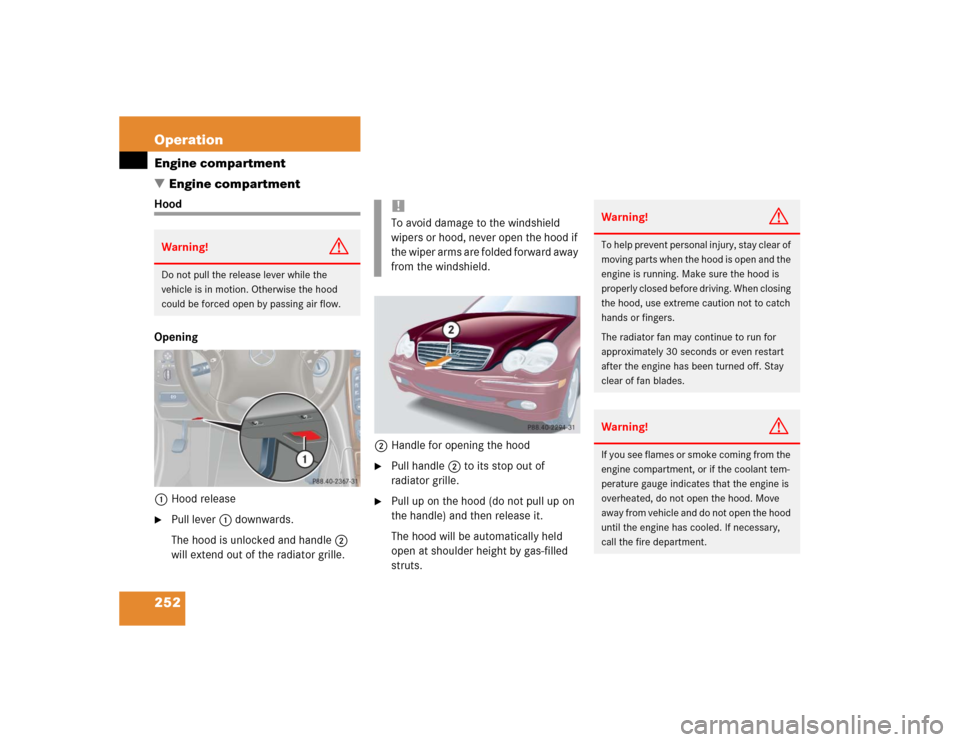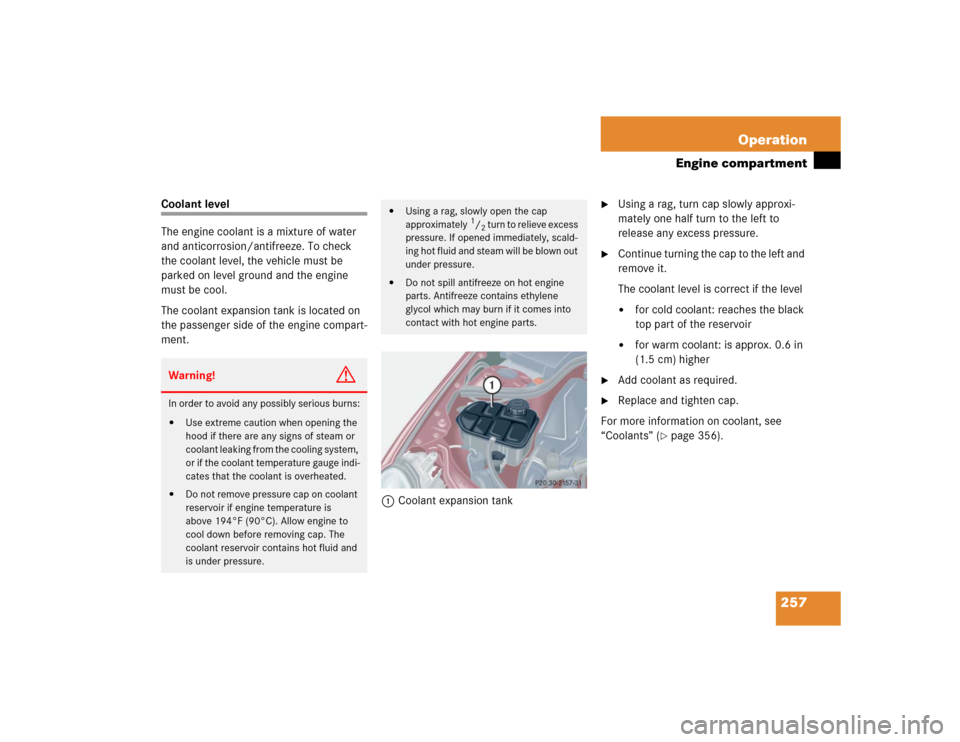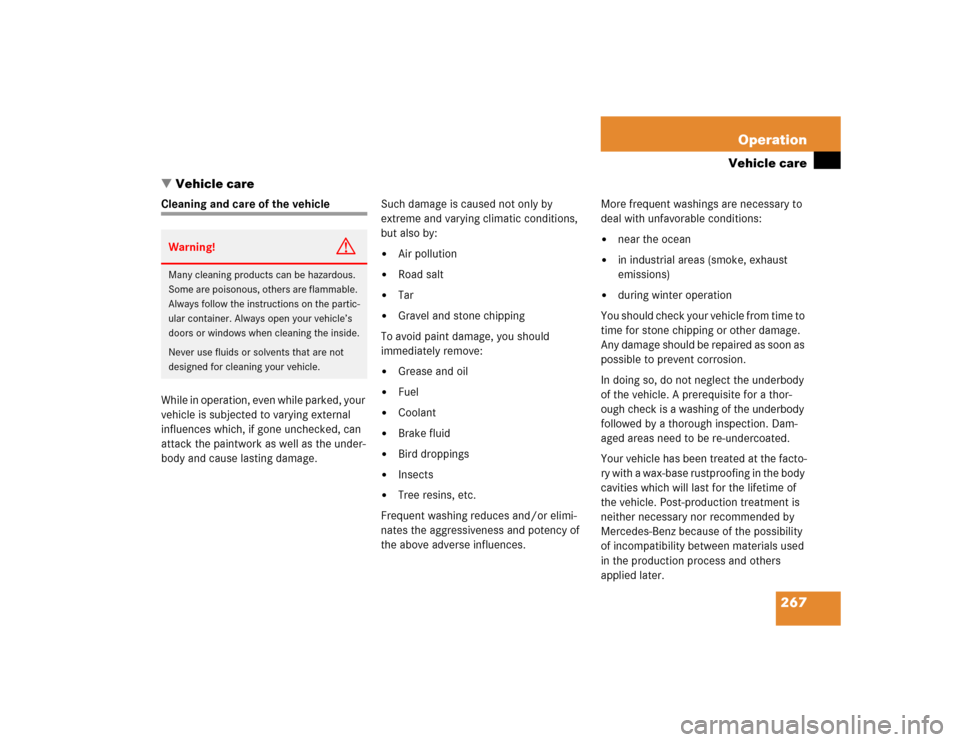Page 248 of 400

248 OperationDriving instructions
Coolant temperature
During severe operating conditions and
stop-and-go city traffic, the coolant
temperature may rise close to
approximately 248°F (120°C).
The engine should not be operated with
the coolant temperature over 248°F
(120°C). Doing so may cause serious
engine damage which is not covered by the
Mercedes-Benz Limited Warranty.
Warning!
G
Inhalation of exhaust gas is hazardous to
your health. All exhaust gas contains carbon
monoxide, and inhaling it can cause
unconsciousness and lead to death.
Do not run the engine in confined areas
(such as a garage) which are not properly
ventilated. If you think that exhaust gas
fumes are entering the vehicle while driving,
have the cause determined and corrected
immediately. If you must drive under these
conditions, drive only with at least one
window fully open at all times.
Warning!
G
�
Driving when your engine is badly
overheated can cause some fluids,
which may have leaked into the engine
compartment, to catch fire. You could
be seriously burned.
�
Steam from an overheated engine can
cause serious burns and can occur just
by opening the hood. Stay away from
the engine if you see or hear steam com-
ing from it.
Turn off the engine, get out of the vehicle
and do not stand near the vehicle until the
engine has cooled down.
Page 251 of 400

251 Operation
At the gas station
Check regularly and before a long trip
1Coolant level
For more information on coolant, see
“Coolant level” (
�page 257).
2Brake fluid (fuse box cover removed)
Removing fuse box cover
(
�page 333).
3Windshield washer and headlamp
cleaning system*
For more information on filling up the
washer reservoir, see “Windshield
washer system and headlamp cleaning
system*” (
�page 259).Engine oil level
For more information on engine oil level,
see “Engine oil” (
�page 253).
Opening hood (
�page 252).
Vehicle lighting
Check function and cleanliness. For more
information on replacing light bulbs, see
“Replacing bulbs” (�page 310).
Exterior lamp switch (�page 102).
Tire inflation pressure
More information on tire inflation pressure
(
�page 261).
!If you find that the brake fluid in the
brake fluid reservoir has fallen to the
minimum mark or below, have the
brake system checked for brake pad
thickness and leaks immediately.
Notify an authorized Mercedes-Benz
Center immediately. Do not add brake
fluid as this will not solve the problem.
For more information, see “Practical
hints” (
�page 275).
Page 252 of 400

252 OperationEngine compartment
�Engine compartmentHood
Opening
1Hood release�
Pull lever1 downwards.
The hood is unlocked and handle2
will extend out of the radiator grille. 2Handle for opening the hood
�
Pull handle2 to its stop out of
radiator grille.
�
Pull up on the hood (do not pull up on
the handle) and then release it.
The hood will be automatically held
open at shoulder height by gas-filled
struts.
Warning!
G
Do not pull the release lever while the
vehicle is in motion. Otherwise the hood
could be forced open by passing air flow.
!To avoid damage to the windshield
wipers or hood, never open the hood if
the wiper arms are folded forward away
from the windshield.
Warning!
G
To help prevent personal injury, stay clear of
moving parts when the hood is open and the
engine is running. Make sure the hood is
properly closed before driving. When closing
the hood, use extreme caution not to catch
hands or fingers.
The radiator fan may continue to run for
approximately 30 seconds or even restart
after the engine has been turned off. Stay
clear of fan blades.Warning!
G
If you see flames or smoke coming from the
engine compartment, or if the coolant tem-
perature gauge indicates that the engine is
overheated, do not open the hood. Move
away from vehicle and do not open the hood
until the engine has cooled. If necessary,
call the fire department.
Page 257 of 400

257 Operation
Engine compartment
Coolant level
The engine coolant is a mixture of water
and anticorrosion/antifreeze. To check
the coolant level, the vehicle must be
parked on level ground and the engine
must be cool.
The coolant expansion tank is located on
the passenger side of the engine compart-
ment.
1Coolant expansion tank
�
Using a rag, turn cap slowly approxi-
mately one half turn to the left to
release any excess pressure.
�
Continue turning the cap to the left and
remove it.
The coolant level is correct if the level �
for cold coolant: reaches the black
top part of the reservoir
�
for warm coolant: is approx. 0.6 in
(1.5 cm) higher
�
Add coolant as required.
�
Replace and tighten cap.
For more information on coolant, see
“Coolants” (
�page 356).
Warning!
G
In order to avoid any possibly serious burns:�
Use extreme caution when opening the
hood if there are any signs of steam or
coolant leaking from the cooling system,
or if the coolant temperature gauge indi-
cates that the coolant is overheated.
�
Do not remove pressure cap on coolant
reservoir if engine temperature is
above 194°F (90°C). Allow engine to
cool down before removing cap. The
coolant reservoir contains hot fluid and
is under pressure.
�
Using a rag, slowly open the cap
approximately
1/2 turn to relieve excess
pressure. If opened immediately, scald-
ing hot fluid and steam will be blown out
under pressure.
�
Do not spill antifreeze on hot engine
parts. Antifreeze contains ethylene
glycol which may burn if it comes into
contact with hot engine parts.
Page 267 of 400

267 Operation
Vehicle care
�Vehicle care
Cleaning and care of the vehicle
While in operation, even while parked, your
vehicle is subjected to varying external
influences which, if gone unchecked, can
attack the paintwork as well as the under-
body and cause lasting damage.Such damage is caused not only by
extreme and varying climatic conditions,
but also by:
�
Air pollution
�
Road salt
�
Tar
�
Gravel and stone chipping
To avoid paint damage, you should
immediately remove:
�
Grease and oil
�
Fuel
�
Coolant
�
Brake fluid
�
Bird droppings
�
Insects
�
Tree resins, etc.
Frequent washing reduces and/or elimi-
nates the aggressiveness and potency of
the above adverse influences.More frequent washings are necessary to
deal with unfavorable conditions:
�
near the ocean
�
in industrial areas (smoke, exhaust
emissions)
�
during winter operation
You should check your vehicle from time to
time for stone chipping or other damage.
A n y d a m a g e s h o u l d b e r e p a i r e d a s s o o n a s
possible to prevent corrosion.
In doing so, do not neglect the underbody
of the vehicle. A prerequisite for a thor-
ough check is a washing of the underbody
followed by a thorough inspection. Dam-
aged areas need to be re-undercoated.
Your vehicle has been treated at the facto-
ry with a wax-base rustproofing in the body
cavities which will last for the lifetime of
the vehicle. Post-production treatment is
neither necessary nor recommended by
Mercedes-Benz because of the possibility
of incompatibility between materials used
in the production process and others
applied later.
Warning!
G
Many cleaning products can be hazardous.
Some are poisonous, others are flammable.
Always follow the instructions on the partic-
ular container. Always open your vehicle’s
doors or windows when cleaning the inside.
Never use fluids or solvents that are not
designed for cleaning your vehicle.
Page 287 of 400
287 Practical hints
What to do if …
Display symbol
Display message
Possible cause
Possible solution
B
COOLANT
CHECK LEVEL!
The coolant level is too low.
�
Add coolant (
�page 257).
�
If you have to add coolant frequently,
have the cooling system checked by
an authorized Mercedes-Benz Center.
Warning!
G
Do not spill antifreeze on hot engine parts.
Antifreeze contains ethylene glycol which
may burn if it comes into contact with hot
engine parts. You can be seriously burned.
!Do not ignore the low engine coolant
level warning. Extended driving with
the message and symbol displayed
may cause serious engine damage not
covered by the Mercedes-Benz Limited
Warranty.
Do not drive without sufficient amount
of coolant in the cooling system. The
engine will overheat causing major
engine damage.
Page 288 of 400

288 Practical hintsWhat to do if …
During severe operating conditions and
stop-and-go city traffic, the coolant tem-
perature may rise close to 248°F (120°C).
Display symbol
Display message
Possible cause
Possible solution
Ï
COOLANT
STOP, ENGINE OFF!
The coolant is too hot.
�
Stop the vehicle and turn off the
engine.
�
Only start the engine again after the
message disappears. You could
otherwise damage the engine.
Warning!
G
Driving when your engine is badly over-
heated can cause some fluids which may
have leaked into the engine compartment to
catch fire. You could be seriously burned.
Steam from an overheated engine can cause
serious burns and can occur just by opening
the hood. Stay away from the engine if you
see or hear steam coming from it.
Turn off the engine, get out of the vehicle
and do not stand near the vehicle until the
engine has cooled down.
!The engine should not be operated with
the coolant temperature above 248°F
(120°C). Doing so may cause serious
engine damage which is not covered by
the Mercedes-Benz Limited Warranty.
Page 289 of 400
289 Practical hints
What to do if …
Display symbol
Display message
Possible cause
Possible solution
Ï
COOLANT
STOP, ENGINE OFF!
The poly-V-belt could be broken.
�
Stop immediately and check the
poly-V-belt.
If it is broken:
�
Do not continue to drive. Otherwise
the engine will overheat due to an
inoperative water pump which may
result in damage to the engine. Notify
an authorized Mercedes-Benz Center.
If it is intact:
�
Do not continue to drive the vehicle
with this message displayed. Doing so
could result in serious engine damage
that is not covered by the
Mercedes-Benz Limited Warranty.
COOLANT
VISIT WORKSHOP!
The cooling fan for the coolant is
malfunctioning.
�
Observe the coolant temperature
display.
�
Have the fan replaced as soon as
possible.